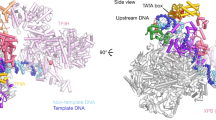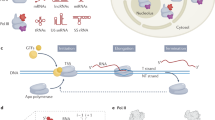Abstract
Rhodes and Klug1 have recently proposed that the internal control region of the Xenopus 5S RNA gene adopts an A-type DNA structure in solution. This suggestion was based on a Fourier analysis of both the spacing of DNase I cutting sites and on the distribution of G residues in the DNA sequence. Both revealed a ~5.6–5.7-base periodicity which the authors interpreted as a structural repeat every half helical turn of A-type DNA. This contention was strengthened by the finding that a 9-base-pair (bp) double-stranded deoxyoligonucleotide corresponding to residues +81 to +89 of the 5S gene exhibits an A′ RNA-like crystal structure2. This region of DNA is of special interest as it forms the binding site for the 5S gene-specific transcription factor IIIA (TFIIIA)3. TFIIIA is a Zn2+-binding protein which interacts with both the internal control region of the gene and the 5S transcript4–6. As base-paired regions of RNA are of the A type2,7, it was reasonable to postulate that 5S DNA might also adopt this conformation1. We report here that the circular dichroism (CD) spectrum of a synthetic 54-bp deoxyoligonucleotide corresponding to the TFIIIA binding site is similar to the CD spectrum of B-form DNA in solution. Further, DNA–TFIIIA complexes show an unaltered DNA CD component indicating no gross alteration in DNA structure on protein binding.
This is a preview of subscription content, access via your institution
Access options
Similar content being viewed by others
References
Rhodes, D. & Klug, A. Cell 46, 123–132 (1986).
McCall, M., Brown, T., Hunter, W. N. & Kennard, O. Nature 322, 661–664 (1986).
Engelke, D. R., Ng, S. Y., Shastry, B. S. & Roeder, R. G. Cell 19, 717–728 (1980).
Miller, J., MacLachlan, A. D. & Klug, A. EMBO J. 4, 1609–1614 (1985).
Diakun, G. P., Fairall, L. & Klug, A. Nature 324, 698–699 (1986).
Picard, B. & Wegnez, M. Proc. natn. Acad. Sci. U.S.A. 76, 241–245 (1979).
Arnott, S., Hukins, D. W. L., Dover, S. D., Fuller, W. & Hodgson, A. R. J. molec. Biol. 81, 107–122 (1973).
Sprecher, C. A., Baase, W. A. & Johnson, W. C. Biopolymers 18, 1009–1019 (1979).
Johnson, B. B., Dahl, K. S., Tinoco, I., Ivanov, V. I. & Zhurkin, V. B. Biochemistry 20, 73–78 (1981).
Arnott, S. & Hukins, D. W. L. Biochem. Biophys. Res. Commun. 47, 1504–1509 (1972).
Tunis-Schneider, M. J. B. & Maestre, M. F. J. molec. Biol. 52, 521–541 (1970).
Peck, L. J. & Wang, J. C. Nature 292, 375–378 (1981).
Gottesfeld, J. M. Molec. cell Biol. 7, 1612–1622 (1987).
Rhodes, D. & Klug, A. Nature 286, 573–578 (1980).
Rhodes, D. EMBO J. 4, 3473–3482
Reynolds, W. F. & Gottesfeld, J. M. Proc. natn. Acad. Sci. U.S.A. 80, 1862–1866 (1983).
Christiansen, J., Brown, R. S., Sproat, B. S. & Garrett, R. A. EMBO J. 6, 453–460 (1987).
Saenger, W., Hunter, W. N. & Kennard, O. Nature 324, 385–388 (1986).
Peterson, R. C., Doering, J. L. & Brown, D. D. Cell 20, 131–141 (1980).
Author information
Authors and Affiliations
Rights and permissions
About this article
Cite this article
Gottesfeld, J., Blanco, J. & Tennant, L. The 5S gene internal control region is B-form both free in solution and in a complex with TFIIIA. Nature 329, 460–462 (1987). https://doi.org/10.1038/329460a0
Received:
Accepted:
Issue Date:
DOI: https://doi.org/10.1038/329460a0
This article is cited by
Comments
By submitting a comment you agree to abide by our Terms and Community Guidelines. If you find something abusive or that does not comply with our terms or guidelines please flag it as inappropriate.



